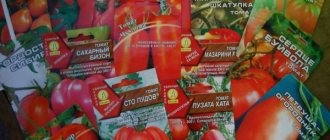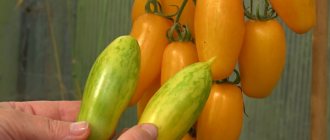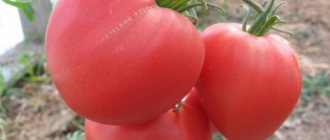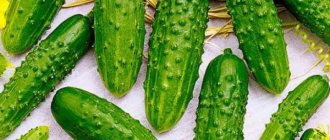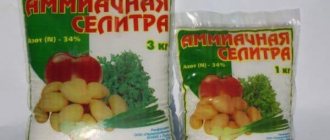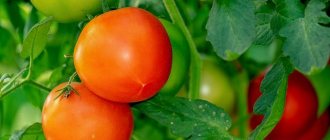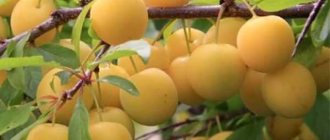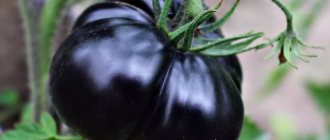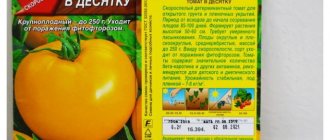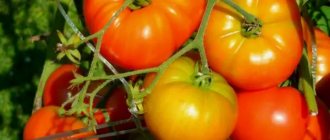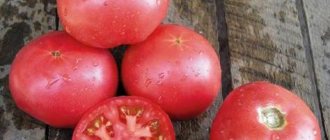Features of growing tomato variety Vologda F1 and its description
Many gardeners try to grow hybrids on their plots, for example, the Vologda tomato.
They differ from conventional varieties in their high yield and greater resistance to many diseases. They are obtained as a result of artificial crossing of two varieties. Typically, packages of hybrid seeds are marked with the F1 symbol. The only thing that is impractical for them is to collect seeds and sow them the next year, since all the maternal qualities of the plant will be lost.
You will have to purchase new seeds every year from specialized stores.
Among the hybrids, the tomato variety Vologda F1 enjoys attention
Description of the variety
Vologda F1 is a mid-season variety. From germination to fruiting there are 110 days. The variety is intended for cultivation in film or glass greenhouses. It can have different heights, the maximum reaches 2 meters.
The fruits are collected in a cluster of 6–8 fruits. The leaves are medium in size and dark green in color. The first inflorescences begin to appear above the 10th leaf. The fruits are medium-sized, their weight is from 100 - 110 grams, the color is red, the tomatoes do not crack, and have a durable film. Well attached to the stalk. When the bush matures, it holds tightly and does not fall to the ground.
Tomatoes are distinguished by their taste, contain a sufficient amount of sugar, and are sweetish. Suitable for home and industrial canning and salad preparation.
Breeding Features
Vologda tomatoes are grown in seedlings. The seeds are sown at the end of February. It is advisable to first soak them in water and treat them in a solution of potassium permanganate. Then sow in ready-made moist soil for tomatoes and peppers, purchased at the store. Cover the soil with film and place in a warm place.
In about a week the seeds will sprout. When the first true leaves grow, it is recommended to pick. To do this, it is advisable to choose disposable cups. To extend daylight hours, it is recommended to illuminate the seedlings with a fluorescent lamp. When the plants are 55–60 days old, they must be transplanted into a permanent place in the greenhouse, following a 40x60 cm pattern.
A prerequisite for care is loosening the soil, especially after watering the plants. To increase the yield of tomatoes, it is recommended to loosen and slightly lift the soil up to the first leaves so that an additional root system begins to form.
In the middle zone, tomato seedlings are planted in early May. After some time, the plants need to be tied to a support and fertilized 2 times a month. In the future, they try to form the plant so that there is one stem; when the maximum height is reached, the top is pinched.
This type of procedure is recommended to be done in August. Until approximately August, abundant watering is carried out; at the beginning of August, irrigation is reduced; towards the end of the month, watering is stopped completely.
Advantages of the variety
The advantage of this tomato hybrid is its resistance to many diseases. Tobacco mosaic, fusarium, and cladosporiosis are not dangerous to it. Unfortunately, like all other tomatoes, it can suffer from late blight. The hybrid is characterized by high productivity. With good care, up to 5 kg of tomatoes ripen on one plant.
To obtain high yields, suitable climatic and weather conditions are important. Reviews of Vologda F1 tomatoes are mostly positive
With proper care, most gardeners get high yields and are satisfied with this variety.
Vologda F1 tomatoes are also convenient because they are easy to transport. The fruits have the most convenient size for canning, so we recommend growing them on site.
The best tomato varieties for greenhouses in the northern regions
Tomato varieties for regions with short warm periods have their own characteristics. Thus, tomatoes should be distinguished by an early period of fruit ripening and high yield. In addition, vegetables must be shelf-stable (transporting tomatoes from distant regions, for example, Khanty-Mansi Autonomous Okrug, can take more than one day).
The best tomatoes for northern regions:
- Lovely lady F1. The hybrid is considered one of the best for growing in Siberia: it is cold-resistant, has genes against TMV, fusarium, and cladosporiosis. Tomato yields up to 6 kg per plant. Lady fruits are red, round, and have an average weight of 200 grams.
- Hermitage Museum. The variety is specially bred for growing in film shelters in the north-west of Russia: it is resistant to high humidity, early ripening (tomatoes can be harvested on the 95th day). Hermitage produces small (100 grams), rounded, red fruits with high taste characteristics.
- Em champion. The name of the variety speaks for itself: the tomato produces up to 30 kg of tasty, smooth fruits weighing 300-500 grams. Em-champion tolerates temperature changes well and is suitable for growing in greenhouses in the Tver region.
Next to early-ripening tomatoes, you can also plant later varieties that can bear fruit until frost. True, in this case, you will need to take care of additional heating of the film greenhouse.
You can learn how to properly heat a greenhouse structure from the material: https://homeli.ru/dvor-i-sad/teplitsy/obogrev-teplitsy
Hybrid Balance F1
Choosing a productive tomato variety for the Vologda region is a responsible matter, and the gardener pays great attention to the growth conditions and disease resistance of the new type of tomato. Tomato Balance F1 has high taste, retains its presentation when fresh and after processing, and tolerates transportation well
The fruits ripen within 95-105 days, the weight of the tomato reaches 300 g
Tomato Balance F1 has high taste, retains its presentation when fresh and after processing, and tolerates transportation well. The fruits ripen within 95-105 days, the weight of the tomato reaches 300 g.
Due to the high sugar content, tomatoes retain excellent taste when pickled. Unripe fruits have medicinal and dietary properties.
It is necessary to plant the seeds of the Balance F1 hybrid in a previously prepared container. The first shoots appear after 14 days. Before planting seedlings in a greenhouse, it is necessary to study the characteristics of the structure: the plants will be transferred to a heated room at the end of April, to a greenhouse made of film - in mid-May. Tomato seedlings should have a developed root system, true leaves with a darker color at the base.
What varieties of tomatoes are best planted for cultivation in the Vologda region
Tomato varieties for the Vologda region are carefully selected taking into account the climatic conditions of the region, and it is determined how to grow the new species.
Common varieties cultivated in Vologda villages are:
Tomatoes are small in size and can be grown in a greenhouse. The plants bear fruit for a long time and are resistant to late blight, which creates many problems for consumers. Amateur gardeners are engaged in growing large-fruited salad tomatoes and caring for seedlings.
Hybrid varieties
The following types of tomatoes are cultivated in the Northwestern Federal District:
- Godfather
- Watermelon.
- Amazon.
- Black master.
- Cardinal.
- Cardio.
Early ripening varieties ripen 2 weeks earlier than other types of tomatoes.
The most common hybrids are:
Gardeners are especially pleased with the large fruits of the Arizona variety. The bush produces up to 16 kg of high-quality fruits. They have a rich red color, weigh from 100 to 400 g, are dense, and contain a large amount of dry matter and glucose. Tomatoes are used to make juice, ketchup, paste, and consumed fresh. Experienced vegetable growers note the marketable appearance of the fruits and their smooth ripening.
Several bushes of the Cardio variety can provide a family with high-quality fruits. Yablonka, Pharaoh, and Dobrun tomatoes are successfully grown on swampy soils.
Tomatoes do not die from excess moisture and produce a good harvest. Seedlings of some hybrids are grown in beds, covered with glass. In the Vologda region, Krasnobay, Kirzhach, and Belcanto tomato seeds are used to produce seedlings.
Olya, Verlioka, De Barao and Ural tomatoes are tasty and aromatic. In order to get a high yield, it is necessary to choose the right variety: it must correspond to the climatic conditions of the growing area.
Early tomatoes for growing in the Leningrad region
The most complete information about tomatoes can be found in the State Register, where varieties are entered by the State Commission of the Russian Federation after they have passed variety testing. Here you can find varieties recommended for cultivation throughout the country. Many of them are quite new: they were included in the State Register in the 2000s.
For cultivation in the first light zone (in the Arkhangelsk, Vologda, Leningrad, Murmansk, Magadan, Novgorod, Pskov regions, as well as in the Komi and Karelia republics), the Federal State Budgetary Institution "State Variety Commission" recommends almost three hundred varieties of tomatoes. Let us dwell in more detail on varieties that have early ripening periods.
Ground Gribovsky 1180
The tomato Gribovsky 1180, included in the State Register back in 1950, is still popular. This early-ripening tomato ripens in 96–112 days after the seeds germinate. It is recommended to grow it in open beds or under film. It shows the best results in greenhouses.
It is determinate, grows up to half a meter high, produces round or somewhat flattened red fruits weighing from 55 to 90 grams. The taste of these tomatoes receives “good” and “satisfactory” ratings. It is recommended to use tomatoes fresh, but they can also be processed into juice. This tomato accumulates 2.5–3.2% sugars. The juice contains from 4 to 6% dry matter. The yield of the variety ranges from 173 to 420 centners per hectare.
Many gardeners praise the old variety from the 50s - Ground Gribovsky 1180
White filling 241
The early-ripening variety White Naliv 241 is well known among vegetable growers and popular among gardeners. The variety received its name for the whitish light green color of unripe fruits, similar to the color of apples of the same name. Ripe red tomatoes.
White filling tomatoes have a good taste and contain up to 3% sugars
It is recommended to eat them fresh. Tomatoes have a good taste and contain up to 3% sugars. The juice contains about 5% dry matter. The plant is determinate, low - up to half a meter. Tomatoes weigh from 80 to 130 grams. The harvest, depending on growing conditions and weather, can be from 275 to 814 centners per hectare. The variety is moderately susceptible to macrosporiosis, but is easily affected by phytosporosis.
Northern
Severenok is an early ripening variety bred by agro
An interesting early ripening variety is Severenok, bred agro and recommended for cultivation throughout the country in open beds and under film covers. It ripens very early and amicably. The harvest can be harvested within 95 days after germination. The plant is determinate, no more than 0.75 meters high. The plants are resistant to tobacco mosaic virus and fusarium wilt, are unpretentious, and can be grown on poor soils and in dry conditions.
Dense round red fruits are suitable for salads and for winter preparations. From 1 m2 of bed you can get 5 kg of tomatoes, which are well stored and can easily be transported. Fruit weight is about 100–110 grams. They have a good sweet taste with a slight sourness.
Which tomatoes are better to plant in a greenhouse under film?
Tomatoes for film shelters have their own characteristics associated with the low throughput of the film. Thus, greenhouse tomatoes for film shelters must be resistant to overheating, temperature fluctuations, and high humidity.
The best varieties for growing in greenhouses:
- De Barao Red. The tomato is excellent for cultivation in central Russia and Belarus. De Barao plants are shade-tolerant, resistant to temperature changes and diseases. The variety has gained recognition due to its high yield (one plant can produce up to 4-6 kg of vegetables). De Barao fruits are plum-shaped with thick skin and can be used as pickling fruits.
- Crystal F1. Early ripening tomato of French selection. The fruits of the variety are red, round, with thick skin, have a good taste in salads and winter preparations, and are resistant to transportation and long-term storage.
- Signor Tomato F1. The hybrid is high-yielding (15-20 kg from an area of 0.1x0.1 cm), with an early period of fruit ripening (vegetables can be harvested on the 95th day), suitable for both film covering and open ground. Signora vegetables have a beautiful, heart-shaped shape, red, smooth skin and fleshy, tasty pulp.
To create the most comfortable conditions for tomatoes in film greenhouses, you can equip them with automatic windows. An automatic thermal drive will open and close the window depending on the temperature change inside the greenhouse, thereby protecting the seedlings from overheating and creating better conditions for ventilation. After all, overheating and drafts can ruin a tomato harvest.
The best, most productive tomato varieties for the new season
Tomatoes are one of the most popular crops in the household plots of Russian residents. Despite the fact that tomatoes were initially cultivated only in warm regions, thanks to the efforts of breeders, today residents of areas with very harsh climatic conditions can also reap a rich harvest.
How to choose tomato seeds
The entire variety of tomato seeds on sale can be divided according to several criteria. There are varietal and hybrid tomatoes. The latter are easily distinguished by the presence of the “F1” marking on the bag. Such varieties are bred artificially and their seeds subsequently do not retain the same characteristics as the parent plant.
The next sign you should pay attention to when buying seeds is the growing method. Among the tomatoes for open ground, as some of the best varieties of the new season, it should be noted:
- The “Bull's Heart” variety is distinguished by its impressive size and special shape, reminiscent of a heart. The fruits are a pleasant pink color. They can reach a mass of up to half a kilogram!
- The variety "De Barao" is a late-ripening variety for open ground, characterized by high productivity. From each bush you can easily collect up to 4 kg of fruit, and the tomatoes themselves are of average size and weight within 100g.
- The variety “Golden Domes” will also please you with its high yield. At the same time, its fruit weight is very significant and can reach 400 grams, so that about 8 kg of tomatoes can be harvested from one bush per season.
Manufacturers also offer a lot of interesting varieties for growing in greenhouses and greenhouses, among which every gardener can find something suitable specifically for their region.
- The “Tornado” variety is a hybrid that ripens in 100-110 days. Since it does not tolerate temperature changes well, a greenhouse will be an ideal option for obtaining a good harvest. And here the variety can please you with a rich harvest (up to 8 kg per plant). Another advantage of Tornado tomatoes is their resistance to common diseases.
- The "Empire" variety is an excellent option for canning. Small tomatoes weighing about 120 grams have a beautiful plum-like shape and retain their density even after salting/marinating.
- Variety "Swallowtail" - suitable for early fresh consumption. The tomatoes are very sweet with excellent taste and ripen already on the 95th day after germination.
Among the early ripening varieties it should also be noted:
- Variety "Alpha" is compact in size. The bush grows only about half a meter high. The tomatoes are small, but have excellent taste and ripen approximately 90 days after full germination.
- The Aphrodite variety is one of the earliest. Ripening occurs already at 75-80 days. The average fruit weight is about 100g. The purpose of tomatoes is universal; they can be used fresh or canned.
- The “Kukla” variety is a hybrid with an early ripening period (85-95 days). The weight of tomatoes can reach 200 grams. The purpose in cooking is universal.
New items for the season
Professional agronomists recommend that gardeners plant both varieties that have been proven over the years, as well as several new products that will help diversify the menu. Among the most interesting new products this season are:
- Variety "Alsu" - tomatoes for fresh consumption. The determinate plant grows more than a meter in height. But the fruits are pleasing with their huge size. Some summer residents managed to grow Alsou tomatoes weighing up to 1 kg!
- The “Watercolor” variety, on the contrary, is suitable for canning. Fruits weighing up to 100 grams have a beautiful oval shape, look great in jars and retain their density after processing.
- The “Dimensionless” variety is a unique new product for those who want to grow the largest tomatoes. The weight of one tomato can reach 1 kg or more. At the same time, the fruits are well stored and do not crack.
The best varieties for growing in open ground
For these purposes, you can find different recommendations. There are people who like the Summer Resident and Cornet, some prefer the Golden Queen and Igrande, there are fans of the Knight and the Lord, and the Crimson Viscount is common. However, in the list of preferences of summer residents, forced to fight the harsh climate, the original varieties, intended specifically for the North-Western region, invariably lead.
Nevsky
One of the oldest varieties, which has been grown for more than four decades, but has not lost its popularity due to the ability to grow in a specific climate without much difficulty. The low bush begins to bear fruit abundantly after 100 days, per square meter. m. Even on the balcony you can collect up to 1.5-2 kg from each bush.
I have been growing Nevsky for a long time. Sweet and small berries are very juicy, unpretentious and easy to care for. I have it in my garden in the summer, and in winter I always have fresh ones, growing it on the windowsill in the kitchen.
Amber
It is productive, capable of producing ovaries even in cold weather, resistant to frost and does not require special care due to its short stature. The small and thin-skinned fruit is rich in vitamins and microelements. Amber is resistant to common diseases and is highly valued by gourmets. Grown in Siberia and thrives in problematic climates.
I love it. And because no fuss is required with it, and because it is very tasty. We do not grow them for sale, but for vitamins to support the immune system. Children love him too.
Amber Baltic
The variety has a very beautiful color and excellent visualization, unfortunately, it is little known, although it is an ultra-early variety, ripens quickly, gives a good harvest and is suitable for any need. It does not require pinching or tying, turns yellow quickly and smoothly, contains a lot of carotene and vitamin C, and can be used in dietary and baby food. It is in high demand among buyers.
I love this variety. We started planting for our grandson, he was constantly sick, lacked vitamins, and he couldn’t eat sour tomatoes. Since then I haven't missed a year. The fruits weigh up to 200 g, there are a lot of them, we eat them with great pleasure.
Tomato Vologda fruitful
The variety is early ripening; tomatoes that have a flat shape and rich taste are used for food. To obtain tomato juice at home, take fruits grown in a greenhouse. Tomatoes are the main component of all types of vegetable salad; their beautiful and juicy pulp gives a piquant taste to sandwiches.
The Vologda fruitful hybrid is grown in open ground. The soil for seedlings is prepared in the fall: using purchased soil “Greenhouse” or a mixture of compost and humus (1:1). The plants germinate well and receive all the necessary nutrients.
At a temperature of +25 °C, seedlings are planted in a permanent place. Before planting tomatoes, water the holes generously with water. It is necessary to monitor the development of seedlings, remove diseased and poorly developing plants.
When there is a threat of frost, individual bushes are covered with film caps. For better plant development, fertilizing is carried out. To stimulate their growth, mullein is used, diluted with water in a ratio of 1:10. Watering rate is 1 liter of solution per bush. From 1 m², even in bad weather conditions, up to 18-20 kg of tomatoes are harvested.
Long-fruited tomatoes
Varieties of long-fruited tomatoes are the result of one of the relatively new areas of breeding.
Tomato variety 'Green Sausage'
A unique productive variety of green-fruited tomatoes for cultivation in open ground and greenhouses.
Tomato variety 'Green Sausage' photo from sadik45.ru
The plants are medium-sized, reaching a height of 1.2-1.4 m. The fruits are elongated in shape, reminiscent of a sausage, grow to about 10 cm in length, and weigh about 100-150 grams. At maturity, the fruits are green, with yellow streaks; spicy to taste, ideal for both fresh consumption and pickling and canning.
Tomato variety 'Orange glasses from Minusinsk'
A variety of medium-early, long-fruited tomatoes with a very unusual name is intended for cultivation in open ground and greenhouses.
Tomato variety 'Orange glasses from Minusinsk' photo from sadik45.ru
Indeterminate, reaches a height of 2 m or more. The elongated orange fruits weighing about 100-300 grams are distinguished by their fleshy, sweet pulp.
Tomato variety 'Korean long-fruited'
An unusually beautiful variety for growing in greenhouses and open ground.
Tomato variety 'Korean long-fruited' photo site dachnaya-zhizn.ru
Plants reach a height of 160-180 cm, the fruits have a rather unusual elongated cylindrical shape, with a gracefully curved tip. The pulp is dense, rich raspberry-pink in color, the weight reaches 200-250, and sometimes 400 grams.
Tomato variety 'Auria'
Original mid-season variety.
Tomato variety Auria photo site www.seeds.net
The bushes are tall (up to 180 cm) and need staking. The fruits are elongated-plum-shaped, 11-15 cm long and weighing 200-250 g, with a rich bright red color when ripe. A distinctive feature of the fruits of the Auria variety is their shape - they seem to be forked at the top.
Tomato variety 'Roma'
'Roma' is a high-yielding mid-season variety of long-fruited tomatoes, which takes about 115-120 days from emergence to fruiting.
Tomato variety 'Roma' photo site tomatland.ru
The variety is intended for cultivation in open ground and under film covers. Determinate plants of the variety reach a height of 0.6-0.8 m. Elongated fruits, shaped like plums, weigh about 60-80 grams. Plants of this variety easily tolerate long-term transportation and are ideal for pickling and canning. The variety is resistant to fusarium and verticillium.
Tomato variety 'American long-fruited'
A high-yielding late-ripening variety intended for cultivation in greenhouses.
Variety 'American long-fruited' photo from www.bloomingarden.ru
Powerful plants of the variety grow up to 2 m high. Red fleshy fruits, about 15-20 cm long and weighing 350-400 grams, are distinguished by high taste. The variety is disease-resistant and high-yielding.
Tomato variety 'Scarlet Candles'
A productive mid-season variety for greenhouses and film shelters.
Variety 'Scarlet Candles' photo site kakdacha.ru
Indeterminate, powerful bushes reach a height of 1.8 m. Narrow cylindrical fruits weighing 60-100 g are collected in clusters. At the ripe stage they are bright pink, the flesh is sugary and sweetish in taste. One of the valuable qualities of the variety is its ability to form an ovary in unfavorable conditions.
Tomato variety 'Firewood'
'Drova' is a high-yielding variety of early ripening: about 90-110 days pass from the emergence of seedlings to the start of fruiting.
Variety 'Firewood' photo site treespk.ru
Determinate (30-40 cm), cultivated in open ground and indoor conditions. When grown in a greenhouse, the bushes reach a height of 50-60 cm. The red fruits are forked at the end, approximately 10-12 cm long, weighing about 80 grams. Dense, low-seeded tomatoes are ideal for canning.
Tomato variety 'Mother's Sibiryak'
Mid-season variety: about 111-115 days pass from the emergence of seedlings to the start of fruiting. Designed for cultivation in open ground.
Variety 'Mother's Sibiryak' photo site happyseeds.ru
Determinate, can reach 1-1.5 m in height. The fruit is cylindrical, elongated, slightly ribbed, intense red when technically ripe, without spots or cracks; the weight is often 63-150 g, but there are specimens weighing about 230 g. Thanks to its dense, meaty structure and spicy taste, it is ideal for preparing salads, pickles and canning.
What varieties of tomatoes for greenhouses do experienced summer residents buy?
Similar articles
If you are a gardener from the Leningrad region and want to grow tomatoes on your plot, then part of your work, namely the search for suitable varieties, has already been done. Just experiment, gain experience, and, as a result, jars of beautiful tomatoes.
The size of the fruit is quite impressive, weighing up to 0.3 kg. The yield is high and amounts to about 10 kg of mature fruits per 1 sq.m. Gardeners note the excellent structure and taste of the fruit, which is why this relatively recently bred variety is rapidly gaining popularity.
In the conditions of the Leningrad region, the stage of growing seedlings cannot be skipped, since the seeds will not survive in the changeable climate of this area. There are no special features in the scheme for growing seedlings.
What makes it special is the inconstancy of the weather: in the morning there can be bright sun, in the afternoon there can be heavy rain, and in the evening there can be gusty winds. That is why breeders were faced with a difficult task: to develop varieties of tomatoes that would be resistant to wind, humidity, and temperature changes.
. Tomatoes weighing up to 1 kg. Plant height 1m.
. Red-raspberry elongated vegetables, 100g each. Perfect for pickling.
Bear in the North
. Tomatoes are pepper-shaped, fleshy, dense. The pulp is rich. Excellent for canning. It is also grown in open ground.
F1 friend
But, unlike varieties, you can’t collect your own seeds! The varieties are somewhat more flexible to growing conditions and do not withstand the “dress code” so strictly. And the seeds are cheaper.
What varieties of tomatoes for greenhouses do residents of the middle zone prefer?
Take any varieties that your family likes to taste, just follow the simple rules:
The bushes of this variety will not suffer from late blight and verticillium wilt. Also, the fruits can be stored for a long time after picking, since they contain a lot of dry matter and are not watery. As for the scope of use, it is very wide.
syl.ru
Characteristics and description of the Far North tomato variety, its yield
Low-growing tomato Far North, refers to early varieties of tomatoes. It is mainly intended for growing in open ground. Excellent for growing in greenhouses.
Description and characteristics
Growing tomatoes on a plot is not so difficult; given the available variety, it is difficult to make a choice in favor of one variety or another. To simplify the process, many turn to the Internet in search of information.
Description and characteristics of the “Far North” tomato variety contains all the necessary data about the tomato.
- Bush: standard, low growing.
- Barrel: strong.
- Inflorescence: simple.
- Height: from 40 to 60 cm.
- Garter: not required.
- Ripening time: 3 months from the moment of emergence.
The central stem stops growing after 6 inflorescences have formed.
- Shape: round, slightly elongated, sometimes slightly ribbed.
- Color: red.
- Size: not large.
- Number of cameras: 4-6.
- Weight: from 30 to 100 g.
- Transportability: excellent.
- Taste: normal with sourness.
- Use: universal.
Features of growing the variety
The peculiarity of “Far North” tomatoes is that they can be grown without sowing seeds for seedlings. The plant is very cold-resistant. Therefore, in April you can plant the seeds directly into the ground. Use ordinary glass jars as shelter.
The variety is early, so the first buds may appear within a month. The ovary will form 45-47 days after germination. And the first red tomato can be picked within three months after planting. Mass maturation occurs on days 93-95. Up to 8 plants are planted per 1 m2.
The plant does not require pinching.
All plant care comes down to watering as needed. And feed at least 1-2 times during the season. Fertilizing is carried out 2 weeks after planting in the ground (if the seedling method was used). Then before flowering. You can fertilize 3 times before the tomatoes ripen.
In order to reap the maximum harvest, summer residents advise:
- Carry out picking (after the appearance of 2 full leaves).
- Grow by seedling method.
- Tie and pin.
Easily tolerates cold and temperature changes.
It is best to water with settled warm water after sunset. By mulching the root zone, you can reduce the number of waterings to 2-3 per season. The plant will take the rest of its moisture during rain.
Harvest volume
The productivity of the variety is high. From one plant you can get up to 1.2 kg of tomatoes. Fruiting is abundant. Up to 2 kg of fruit can be collected per 1 m2. Subject to all rules and requirements, pinching and gartering, one plant can produce up to 2.5 kg of yield.
Disease susceptibility
Tomatoes of this type are valued because they are resistant to many diseases. For example:
- Top and root rot.
- Late blight.
Not being susceptible to diseases that affect other varieties has made “Far North” tomatoes very popular among many summer residents. Early harvesting makes it independent of the widespread spread of late blight.
Eating
"Far North" is excellent for canning. Many people prefer to prepare salads from it, using tomatoes to prepare lecho, assorted vegetables, and juices.
Suitable for whole canning. The fruits retain their integrity and the internal structure is not destroyed.
Opinion of people involved in growing tomato crops
The presence of a large amount of information on the Internet about everything in the world makes life easier for a novice gardener. But reviews are most in demand. Reliable information from gardeners about a particular variety becomes an important help. Far North, tomatoes that conquered everyone with their cold resistance.
“Far North” are those tomatoes that were originally bred for regions where farming is unsustainable and weather conditions are unstable. Its early maturity is perfect for those places where summer passes in a short period of time. Summer residents fell in love with this variety for its resistance to diseases and cold resistance. And also the fact that it perfectly tolerates temperature changes and rainy summers. Having chosen these tomatoes, few people regretted their decision.
Variety "Agatha"
Due to the small size of the bush, this variety can be grown even in an apartment. Seeds can be sown directly into open ground in mid-May, but then they must be covered. Also, these bushes are suitable for small garden plots.
Since the bushes are low, there are no special features in their care. When pinching, you need to remove most of the side shoots so that the plant has a strictly defined stem. It is also recommended to create additional support for the bushes in the form of a trellis and a stake near the bush. Watering should be done frequently and not very abundantly, and with warm water. During the period of growth and development, you need to do 2 - 3 feedings so that the plant can quickly take root and actively bear fruit in the open ground or greenhouse. Sevruga . A plant up to 80cm high produces sweet vegetables weighing up to 1300g.
. Bush up to 30cm high. Combines short stature and large fruit. Round and red vegetables contain a lot of sugar and vitamins. Cold-resistant.
Nastenka
. Early ripening. Dense, smooth round tomatoes, 80g each. Excellent taste. Simultaneous ripening makes it possible to harvest the crop with brushes.
© Author: Dmitry VOLKOV, biologist, St. Petersburg If These tomatoes can survive in conditions of cold nights, light frosts on the soil and 12 hours of daylight. Despite the fact that low temperatures are not terrible for the above tomatoes, they also bear fruit well. From 100 bushes you can collect at least 30 ten-liter buckets of fruit, the size of a child’s palm.
Giraffe, Master, Karotinka
Almost simultaneous ripening of fruits.
Ground and greenhouse tomatoes
Tomatoes for open ground in Belarus must ripen quickly so that pests do not have time to go through all their development cycles, and have frost resistance during early spring or late autumn temperature changes.
Early ground varieties include:
- Buddy F Determinate group, hybrid, matures in 100 days. Excellent resistance to bad weather, sunlight and transportation. Medium-fruited, sweet with sourness. FIGURE 2
- Excellent 176. Used in all types of cooking, medium-fruited variety.
- Euro F Hybrid, medium fruiting and high yielding. Semi-determinant group.
- Motto. An early determinate group, with a low-growing bush. Tomatoes grow to a weight of 100g.
- Baby. Determinate, Belarusian early variety. Round, dense tomatoes weighing 40 g. Grows well in open ground and is used for home pickles.
- Storm F Medium growth, semi-determinate, hybrid tomato with high yield.
- Emerald. Low-growing determinant with a good yield and fruit weight of 90g. Unpretentious to changes in temperature and humidity, used for home pickles. Resistant to late blight. FIGURE 3
- Early -310. A bush of medium height, a determinate tomato, characterized by good taste and a high content of vitamin C. Bushes of this variety have the best yield indicators.
- Praleska. Medium growth bush, determinant round-flat shape with a spout. The average weight of the fruit is 90-100 g. Universal use in the kitchen.
- Profitable. A popular and long-standing variety grown in Belarus. Unpretentious determinant, tomato weight 60-80 g. Good harvest.
- Ranitsa. Oval, medium-sized determinant, resistant to crop diseases. FIGURE 4
- Fire. Medium-sized, determinate, does not need much attention.
Soil mid-early varieties:
- Agate. The growth of the bush is low, determinate type, with a fruit weight of up to 100 g. People note the excellent taste.
- Peremoga. A medium-sized variety with a flat-round fruit shape, excellent taste and stable yield.
- Start F Indeterminate hybrid type with a weight of up to 130 g and a large yield. Has high commodity liquidity.
- Kalinka. Determinant, bush of medium height. The tomato weighs up to 70 g, excellent reviews of taste and good harvest.
- Orange-1. A round tomato with a smooth orange skin and weighing up to 120 g. Determinant. Contains an increased amount of carotene. FIG 5
- Present. The bush is low, up to 45 cm, but the tomato is large, weighing up to 120 g. One square meter produces 8 kg of tomatoes. Popular for making homemade pickles, semi-finished products, and salads.
- Vezha. Indeterminate. A tall bush with a fruit weight of 120 g. It has been repeatedly noted as a tomato with the best taste.
- Prize. The height of the bush is up to 40 cm. The weight of the tomato is small, up to 70 g, and is widely used for pickling or preparing semi-finished vegetable products.
- Vilina. A classic determinant with great taste.
- Boom F Hybrid, with a fruit weight of 110-120 g, grown for salads and pickling.
- Ruzha. Medium weight tomato with excellent taste. Grown for home pickles.
- Black Prince. A universal variety that grows in any conditions. Salad use. Raspberry dense tomato 300-400 g, the bush reaches a height of 2 m. Resistant to diseases. FIG 6
Tomatoes for the greenhouse: the best varieties of 2021 and reviews
Tomatoes of Japanese selection received good reviews in 2021. For example, KS 4462 is a super productive variety, the fruits of which are sweet and fleshy, have a round shape, red, dense skin, and retain their presentation well, which is very important for sale. The fruits of Tisato tomatoes, which have an attractive appearance and high taste characteristics, are also in demand on the market in 2021.
In Ukraine, the delivery of tomato seeds is carried out by the online platform “Senior-Tomato”; in Russia and Belarus, elite tomato seeds for seedlings can be found on Valery Medvedev’s website. Professional varietal tomato seeds with delivery can be ordered from the Gavrish company and the SeDek company.
The discovery of 2021 was black tomatoes, which have a pleasant taste and high content of vitamins. Good reviews were received by such varietal tomatoes as the Black Prince (black-raspberry fruits, fleshy, large) and Chernomor (salad vegetables, large, resistant to cracking, suitable for growing both in a greenhouse and in open ground).
The nuances of growing tomatoes in the Leningrad region
Gardeners growing tomatoes in the Leningrad region willingly share their experience online with those who are just starting to grow tomatoes in this region. Combining the accumulated experience of growing tomatoes on plots near St. Petersburg, we can give the following recommendations:
- Almost all tomatoes in this region are grown from seedlings. Care should be taken when choosing varieties. For beginning gardeners and those who go to the countryside no earlier than May, it is better to stick to determinate varieties. Their fruits will have time to ripen on the bushes over the summer.
- Seeds are sown for seedlings approximately 50 days before planting in a permanent place. Early ripening varieties are sown until mid-April, late varieties - no earlier than March 10. Significantly more seeds are sown than it is intended to grow tomatoes, in order to be able to cull weak and unhealthy plants.
- Seeds are sown in a purchased special soil mixture or the soil is prepared independently from equal parts of garden or turf soil, peat, river sand and humus, adding a glass of ground eggshells to ensure a sufficient amount of calcium.
- When growing seedlings, artificial illumination with fluorescent, LED or special lamps must be used. On cloudy days, additional lighting must be provided from 8:00 to 21:00.
- Seeds should be germinated in a container covered with film or glass while maintaining a temperature of 25 ºC. The temperature in the room where the seedlings are grown should be 20–22 ºС. A hot room should be ventilated often.
- Water the seedlings only when the top layer of soil dries out.
- It is good to feed seedlings with vermicompost, but only half the recommended amount. It is better not to use mineral fertilizers.
- You can plant seedlings in a greenhouse from the beginning of May, but only in warm weather. If during this period there was a cold snap or snow fell, which often happens in the region, you should wait until it warms up. In this case, the soil for planting should warm up well to approximately 15 ºС to a depth of at least 10 cm. Sandy loam soils warm up faster than loamy soils.
- Young plants in a greenhouse or in a garden bed after rooting (7–10 days after planting) are first fed with potassium and phosphorus fertilizers according to the instructions for them, avoiding nitrogen fertilizing so that excessive growth of green mass does not begin.
- At the beginning of tomato flowering, a universal fertilizer for nightshades that does not contain chlorine will be useful. For example, “Tomato Sudarushka”. It is applied in the form of a solution of a teaspoon of the drug in a bucket of water. Each plant is watered with 0.5 liters of this liquid.
- Tomatoes are watered regularly, usually 1-2 times a week, focusing on the drying of the top layer of soil and depending on the weather. Water for irrigation should be warm +20 ºС.
- If there is a lack of organic mulch, the space between the planted tomatoes can be sown with white mustard, which will perfectly serve as a green manure that enriches the soil; after the green mass has accumulated, it is cut off and becomes mulch.
- If May turns out to be cold, the tomatoes are covered in the open air with a non-woven fabric attached to arches made of dense wire.
- As soon as the seedlings begin to grow, they begin to perform pinching on varieties that require it. On determinate varieties, up to three stepsons can be left above the first cluster; this will increase the yield, but slightly delay ripening. To obtain an early harvest, all the stepsons on the plants are removed, that is, the plant is formed into one stem. Stepchildren should be removed until their height is no more than 2 cm.
- To ventilate the root zone of plants as they grow, begin to remove the lower leaves 1-2 times a week (no more than two on one plant at a time).
- The greenhouse should be regularly ventilated in warm weather from 8 a.m. to 8 p.m. In rainy and cool weather, ventilation can be completed at 17–18 hours.
Growing tomatoes in the Leningrad region is not an easy task, requiring the gardener to have certain knowledge and skills. Not everything can be read in literature or on the Internet. Experience is gained through trial and error, but the satisfaction from the result obtained outweighs all the work and worries. For this reason, even novice gardeners should not give up growing tomatoes in the Leningrad region.
Hybrid Vologda motifs
Tomatoes intended for cultivation in open ground have become widespread. They compare favorably with other varieties because they have unlimited growth. Planting is done in the ground in June, and seeds are planted in the greenhouse in April - May.
The main characteristic of the variety is its unusual leaves that resemble lace. The pulp of the fruit is dense, rich, tasty and aromatic. Plants in open ground are planted immediately after planting.
To prevent late blight disease, the first treatment of tomatoes with systemic preparations is carried out during the period of their intensive growth, without waiting for signs of the disease to appear.
Tomato Vologda motives has a germination rate of 96%
Experienced gardeners pay attention to the plant’s need for moisture, and when growing a determinate variety, they form the bush like a fruit tree
Seedlings are planted according to the planned pattern: the distance between plants is 30 cm, in rows - 60 cm. The best varieties, with proper care, give a high yield. Plants grow powerful and need to be tied up.
